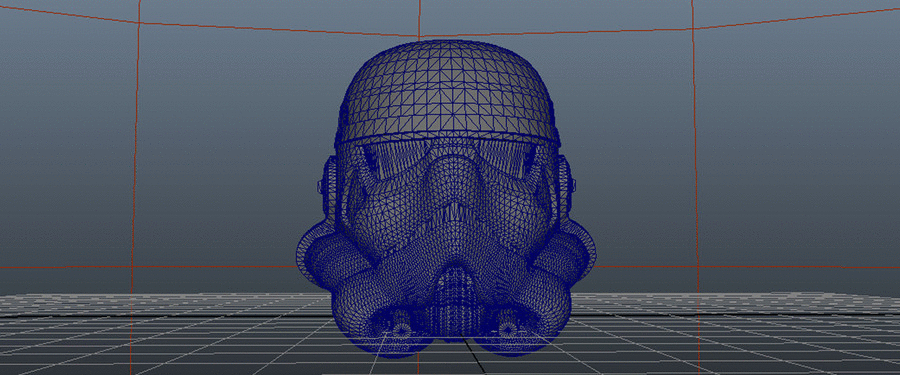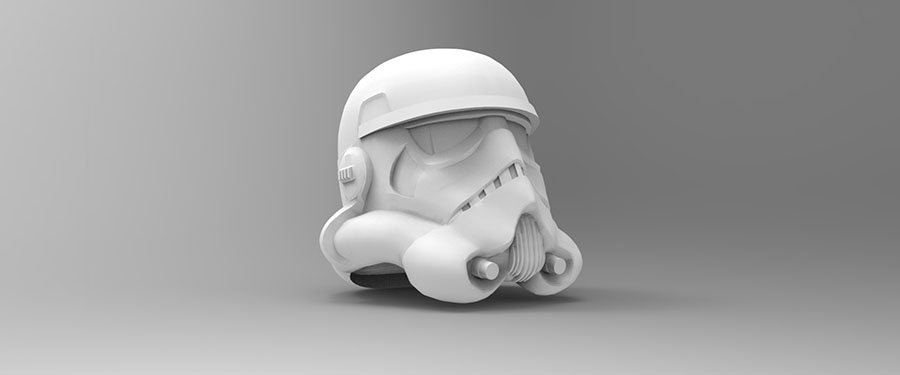Getting Started with 3D Printing
3D Printing, or additive manufacturing, is a subset of digital manufacturing that allows the rapid production of physical parts from a digital file. Although there are many types of 3d printers, and multiple methods of additive manufacturing, each process starts with a digital file. 3D printing is advantageous when it comes to precisely producing refined and accurate physical models and the inputs need to be precise as well.
3D File Generation:

To have a successful 3D printable file, digital geometry must satisfy 3 criteria.
- The model must be “water-tight”. In layman terms, this means that there are no holes in the shell of the model. In more technical terms, the model must be “manifold”.
- In the digital world, any surface will have a front and a back face. This surface orientation is called a “normal”. Normals must be unified. If two adjacent surfaces have different normal directions, this file input may confuse the 3D printer.
- All components of the model must have thickness. While some 3D printing materials are capable of higher resolution and greater detail than others, trying to print geometry without any thickness will not work.
If these 3 criteria are satisfied, you have a model with manifold geometry.
3D File to 3D Printer:

Once a file is ready for the printer, there is a process of converting the 3 dimensional volume into thin sections and paths that the printer can read. This “slicing” is usually done by a proprietary software corresponding with a specific 3D printer and can calculate extruder paths, as well as support material that may be needed when printing overhangs. All 3D models are made from building up layer after layer of material like a topographic map. This process translates the geometric volume into G-code, a programming language that the 3D printer can read.
3D Printing Methods:
3D Printing is really an industry buzz word for “additive manufacturing” first invented by Chuck Hull of 3D Systems in 1984. Today, there are many different ways to 3d print an object, each with their own strengths and weaknesses. It’s important to remember that no printing method is better than another. Some are faster, some produce more durable parts, some have higher resolution, some are less expensive, some are able to be casted, and some allow for larger parts than others. Each project has its own unique set of criteria and an optimal 3D printing technology to best suit its needs.
FDM (Fused Deposition Modeling)
Fused Deposition Modeling works by melting thermoplastics such as ABS or PLA plastic. The material starts as a spool of material that is melted and extruded layer by layer by a heated extruder moving in the X and Y axis on gantry while the build plate moves in the Z axis. This is the most frequently seen printer in the “consumer” and “prosumer” category of desktop 3D printers.
Materials: PLA (Polylactic Acid) or ABS (Acrylonitrile butadiene styrene) are both thermoplastics that start in spool form, each with their own pros and cons.
Speed: Relatively slow because the printer can not lay an entire layer in one pass, and has to follow paths to form an outline and then fill-in.
Strength: Very Strong and durable parts capable of being functional.
Size: (11.2”x6.1”x6”) for PLA (8”x8”x6”) for ABS
Surface Finish: High Resolution but visible striations of print layers
Support Material: Break off material for PLA, dissolvable material for ABS prints.
Post Processing: Bath wash to remove support material
Used for: Architecture models, durable prototypes, functional parts, “looks like- feels like” models
3DP (Powder-based color printing)
3DP is the closest to actually being “3D Printing” because it uses an HP inkjet print head to actually print color onto models layer by layer. These powder printers are typically referred to as “Z printers” because they are made by Zcorp, which was acquired by 3D Systems and then re-released as the Projet line of 3D printers. The process resembles selective laser sintering, except that instead of powder being sintered by a laser, the material is adhered using a binding agent. This is a very sustainable method of 3D printing because unused material is recycled back into the machine leaving zero waste material and no need for support material.
Materials: Powder-based material that is basically gypsum plaster.
Speed: This is the fastest mode of printing we currently offer. It is about 1 hour/ vertical inch.
Strength: Parts using this method of 3D printing are delicate. However, there are methods of post-processing which can give these prints higher strength.
Size: Larger build volume (10″x15″x8″)
Surface: A coarse, matte surface texture with full CMYK color capabilities
Support Material: Because any over-hangs are held up by compressed, unbinded powder, no support materials are necessary.
Post Processing: After model is excavated from print volume, the model is dried and a liquid called “Z-bond” is applied to increase the strength of the model.
Used for: Presentation models, architecture models, figurines, full color prints, “looks-like feels like” prototypes
SLS (Selective Laser Sintering)
SLS uses a high power laser to bind materials together, layer by layer. It’s a very versatile method of 3D printing.
Materials: Powder Nylon. This can be seen in other locations as “White, Strong, and Flexible” or “Polyamide”
Speed: Relatively quick because multiple models can be built at the same time.
Strength: Very strong and durable while simultaneously rigid and flexible.
Size: Larger build volume
Surface: Sanded and slightly grainy appearance
Support Material: Because any over-hangs are held up by compressed, unbinded powder, no support materials are necessary.
Post Processing: After model is excavated from the print volume, the model is cleaned with compressed air to remove excess powder material.
Used for: Complex durable parts and prototypes
SLA (Stereolithography)
SLA uses a low power laser to “cure” photosensitive resin. The resin hardens and is built up layer by layer into the desired object.
Materials: UV cured resin, usually acrylic based
Speed: Higher resolution and slower builds
Strength: Strong parts, but not always the right material characteristics for functional parts. Prolonged exposure to sunlight can weaken parts.
Size: Smaller build volume
Surface: Very smooth surface finish
Support Material: Tiny columns of material that break off after curing print.
Post Processing: Prints cure in alcohol or proprietary solution.
Used for: Creating prototypes for making molds, figurines, small high resolution prints, presentation models, prototypes
3D Printing as a Tool
It’s important to think of 3D printing as a tool like any other tool – in some cases it is wonderful, fast, and efficient solution, and in some cases it isn’t. As a tool, each method of printing and material all have unique characteristics, strengths, and limitations. If 3D printing is a hammer, not all problems are nails – and just because something can be printed doesn’t always mean that it should.
Given a project, 3d printing may be an amazingly effective tool to realize an idea. However, 3d printing can also compliment traditional manufacturing techniques, be casted or post-processed with additional materials, or used as a primer for tooling for mass-manufacturing. Learn more about 3d printing at Pixel Practice

